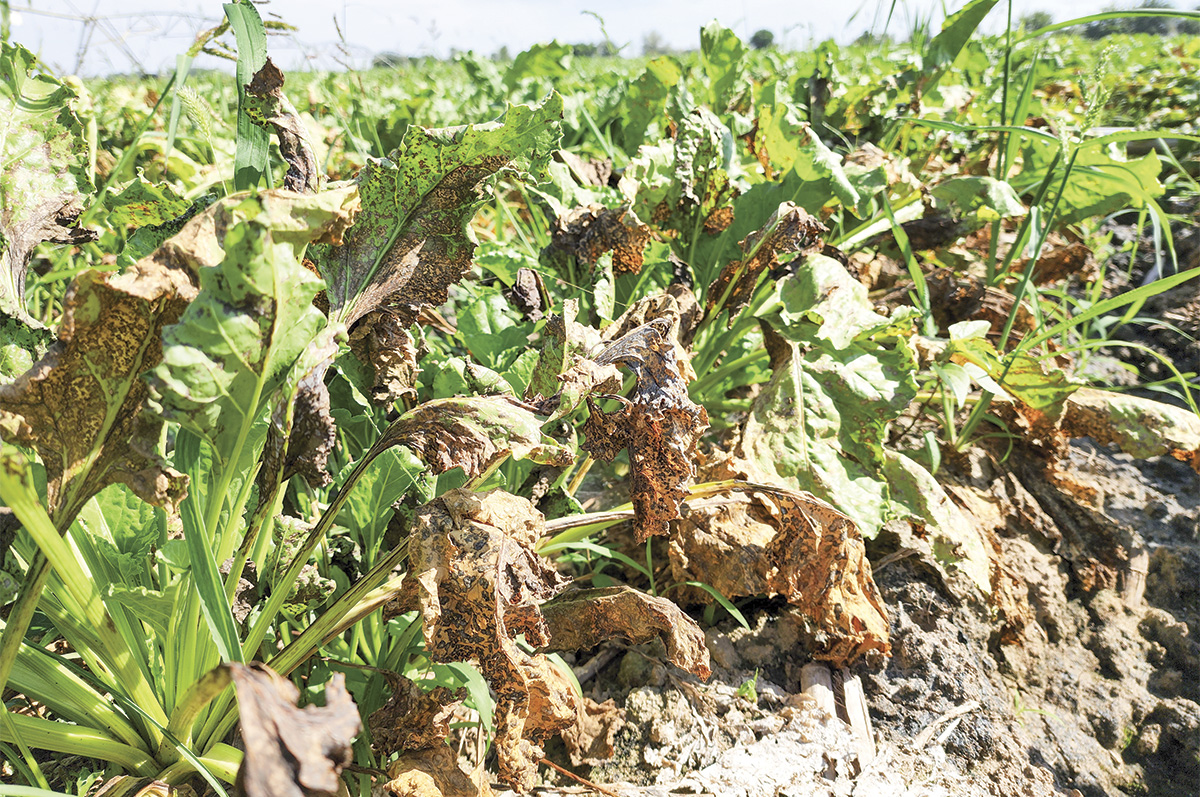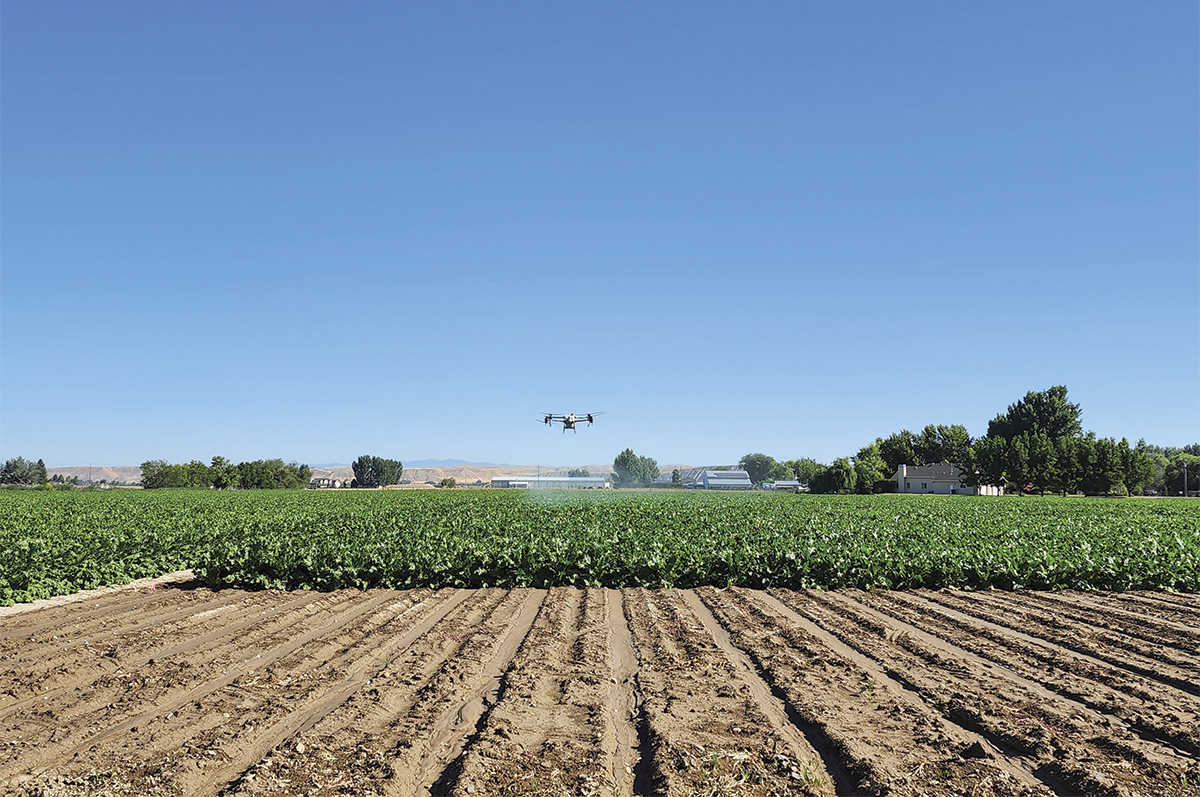"It's cercospora leaf spot," a phrase no sugarbeet grower wants to hear from their crop consultant, especially as it becomes more common in Idaho.
These small circular spots, about 1/8-inch wide, show up on leaves with gray centers and dark brown or reddish-purple edges. Despite their size, these lesions can cause massive problems, leading to yield losses and sugar losses of up to 50% to 60%, if not managed.
Ryan Samples, a sugarbeet grower from Burley and member of the Snake River Sugarbeet Research and Seed Alliance, acknowledges the challenge of identifying cercospora. "It's just a small spot on the leaves … but once it turns brown, you know it's there, and by then, it's too late," he says.
Cercospora has long been a concern in sugarbeet production, particularly in northwestern Minnesota and eastern North Dakota, also known as the Red River Valley, where the majority of sugarbeets in the U.S. are grown. With extensive experience in managing this disease, these regions have honed their strategies over the years. In contrast, Idaho has relatively less familiarity with the disease with only sporadic instances occurring around the Snake River – until now.
Dr. Oliver Neher, chief scientist and senior plant pathologist at the Amalgamated Sugar Company, reflects on his transition to the University of Idaho from Montana State University in 2009, recalling, “I was excited that I was going to a new state, and I could continue my cercospora trials – and in 2009 there was no cercospora.”
In recent years, however, Neher has observed a troubling trend. Since 2017, there has been a notable increase in infected sugarbeet fields, particularly in the Treasure Valley. Over the past two to three years, a widespread outbreak of cercospora has been evident, with fields in 2022 and 2023 experiencing significant damage.
Understanding disease development
Neher elaborates that damaging levels develop when small lesions merge to create larger necrotic areas on the leaf, diminishing the plant's ability to photosynthesize and produce sugar. Additionally, depending on the environment, new infection cycles can occur every 10 to 14 days, resulting in substantial foliage and energy loss in sugarbeet plants.
“It’s really only been bad the past few years to where everybody's really starting to notice,” says Hayden Woods, a graduate student at the University of Idaho working under plant pathologist Dr. James Woodhall. Their focus on powdery mildew and rhizoctonia shifted when cercospora emerged as a significant issue in their sugarbeet trials, leading to further investigation.
This fungal infection thrives in warm and humid environments, where temperature and relative humidity play crucial roles in its development. "The Treasure Valley and the Magic Valley are both semiarid deserts, so we don’t have consistent high relative humidity," Woods notes. "However, we do irrigate, and that has been one of the big focus areas of my research."

Infected leaves lose their ability to photosynthesize and produce sugar. Photo provided by Holly Luna.
In a recent study, Woods compared furrow irrigation with sprinkler irrigation in the same sugarbeet field. The results showed that sprinkler irrigation significantly increases disease compared to furrow irrigation, primarily due to moistened leaves that create favorable conditions for spores. Additionally, consistent irrigation or overirrigation leads to higher disease incidence and lower yields due to increased water stress.
Woods advises growers to use either the traditional hand test to gauge soil moisture or consider investing in soil moisture sensors. “What you’ll come to find is that sugarbeets actually have quite a deep root system. They can access water, 3 to 4 feet down and maybe if it’s a little dry on top, those sugarbeets are still doing OK,” Woods explains.
Cercospora symptoms typically appear after row closure, which creates a microclimate conducive to the pathogen's growth, explains Neher. In the Treasure Valley, this usually occurs from the third week of June until October. However, for growers such as Samples in the Magic Valley and Upper Snake regions, it occurs slightly later.
"A lot of growers refrain from spraying because we're nearing harvest, and most sprays last 14 to 21 days. So it's challenging to time spraying effectively when it's close to harvest," Samples remarks.
While fungicides have been a cornerstone in combating this disease, there is a growing concern about overreliance on them among researchers. Growers must integrate alternative disease management strategies beyond fungicides, given the high resistance levels occurring in populations.
Stopping the spread
Cercospora leaf spot primarily stems from infected sugarbeet debris in fields, spreading through wind dispersal. Planting sugarbeets near previously infected fields leads to disease transmission across seasons, which is why consecutive plantings have long been discouraged.
In a two-year study, Woods assessed post-harvest soil for cercospora presence, finding pathogens detectable even after two years. He hypothesizes it may dissipate by the third year, pending further studies this summer.
“I think there has been some management that we just didn’t realize how big of a problem we were creating,” Woods says of the increased cases of cercospora. “Everybody knows sugarbeets are an economically important crop, and so growers often want to shorten their rotations and grow them as close together as possible … We’re basically holding an inoculum bank in our fields at the end of each season."
Amalgamated Sugar’s trials have also shown similar trends. Neher strongly encourages growers to incorporate infected leaves into the soil to allow soil microorganisms to break down cercospora efficiently. This method, though somewhat controversial, requires a shift back to traditional plowing practices.
“If you can bury it as little as 4 inches, then all it takes is roughly 12 to 24 months to decompose those [infected debris] effectively,” Neher says. "If you have cercospora in your field, plow or bury it. If you don’t have it, it might not be necessary, but it would be highly recommended just to get rid of your leaf material in case it is infected."

A drone flies above, spraying for cercospora. Photo provided by Holly Luna.
In Woods' research, he observed an initial increase in pathogen levels after plowing in plots following sugarbeets. However, over 24 months, there was a significant decline in pathogen levels, similar to other tillage methods. This highlights the potential impact of the time interval between beet crops compared to the specific tillage technique used.
From a grower's perspective, Samples highlights the difficulty of shifting mindsets. He explains, "The plowing thing is tough. They've even decided that if you can just turn it over, bury it 4 inches deep, it will go away. So it's not like we have to go back to the 1-foot plow, but you still have to get everything turned under at least 4 inches. Some guys think a heavy disk will do the job, but if you can still see leaves on top, that’s not effective enough."
Proactive approaches
New this year, cercospora seed varieties were available with limited quantities. As a chairman of the Snake River Sugarbeet Research and Seed Alliance, Samples explains that priority was given to areas with the greatest need. This year, it was approved for the Nyssa and Nampa District and part of the Elwyhee District, and at the King Receiving Station in Wendell. Looking ahead to 2025, Samples anticipates the availability of even more varieties, which will increase seed availability.
One of the crucial reminders for growers is the necessity of maintaining their spray programs even with tolerant varieties in place. “We need to be more proactive with our fungicide sprays, especially the preventative ones,” Samples emphasizes. The challenge is that it requires an additional application separate from Roundup, as combining them can harm the crop. While some growers may be hesitant about the extra pass through the field, Samples says, “I think looking at things, it’ll be worth it.”
For more information or questions regarding cercaspora, please contact Oliver Neher, Hayden Woods or James Woodhall.







